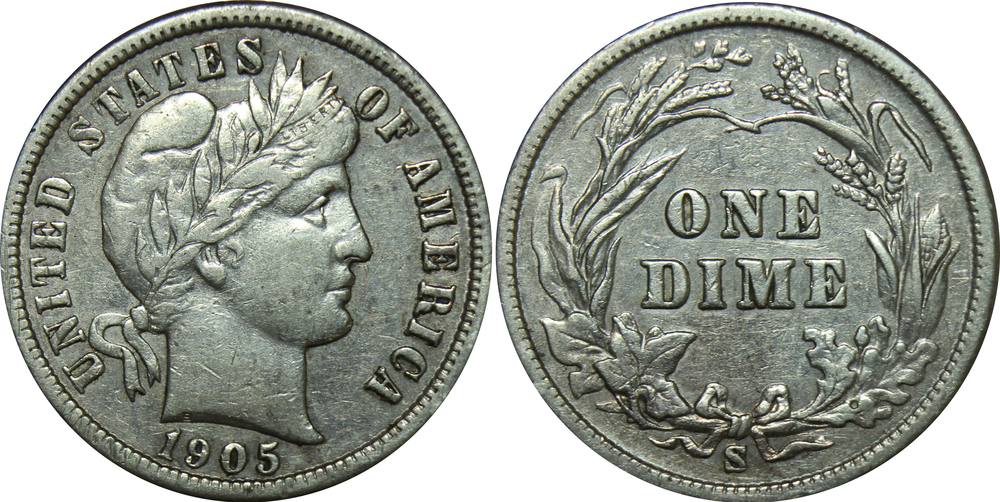The Barber Silver Dime, also known as the Liberty Head dime, is a well known piece of American numismatic history. Minted from 1892 to 1916, this coin carries a rich legacy that reflects the artistry and economic conditions of its era. High grade Barber Silver Dimes can be worth a lot of money while old worn silver dimes are a favorite for stacking silver. There’s a lot to cover, we’ll discuss the history, mintages, and other fascinating aspects of the Barber Silver Dime.
History of the Barber Silver Dime
Out of all the silver dimes produced by the U.S. mint, the Barber Silver Dime is one of the most popular. This silver dime was designed by Charles E. Barber, the Chief Engraver of the United States Mint from 1879 until his death in 1917. The coin’s design was part of a broader initiative to update the appearance of American coinage in the late 19th century.
- Design Origins: In 1891, the U.S. Mint organized a competition to redesign the nation’s coinage, including the dime, quarter, and half dollar. However, none of the submitted designs were deemed satisfactory, leading to the decision to have Barber create the new designs. Barber’s Liberty Head design features a profile of Lady Liberty wearing a Phrygian cap and a laurel wreath on the obverse, while the reverse showcases a simple wreath surrounding the denomination “One Dime.”
- Introduction and Circulation: The Barber Dime was first struck in 1892, replacing the Seated Liberty Dime. It remained in circulation until 1916, when it was succeeded by the Mercury Dime. The Barber Dime was widely used in commerce during its 24-year run, reflecting the economic conditions and everyday transactions of the time.
Barber Silver Dime Mintages and Key Dates
The Barber Dime was produced at several U.S. Mint facilities, including Philadelphia, Denver, New Orleans, and San Francisco. The mintages varied each year, with some dates being more common and others becoming prized by collectors due to their rarity. In other words, you don’t want to sell this silver, you may have a silver dime worth a LOT of money.
- Philadelphia Mint (No Mint Mark): The Philadelphia Mint produced the highest number of Barber Dimes, with several notable key dates.
- 1895: With a mintage of just 690,000, this year is one of the most sought-after by collectors.
- 1901-S: Another key date, the San Francisco Mint produced only 593,022 dimes this year, making it highly valuable.
- New Orleans Mint (O Mint Mark): The New Orleans Mint produced Barber Dimes intermittently until 1909.
- 1894-O: With a mintage of 720,000, this is a key date for collectors.
- 1909-O: The final year of production at the New Orleans Mint saw a relatively low mintage of 2,287,000.
- San Francisco Mint (S Mint Mark): San Francisco Mint issues are generally scarcer, especially in high grades.
- 1896-S: With only 575,056 minted, this year is particularly rare.
- 1913-S: Known for its low mintage of 510,000, this is a prized coin for enthusiasts.
- Denver Mint (D Mint Mark): The Denver Mint began producing Barber Dimes in 1906.
- 1914-D: With a mintage of 11,908,000, this is one of the more common issues but still of interest to collectors.
Collecting Barber Dimes
Collecting Barber Dimes can be a rewarding pursuit, offering insights into a significant period of American numismatic history. If you want to learn more about other Barber coins, check this out: Barber Silver Quarters ; Let’s take a closer look at collecting Barber dimes.
- Condition and Grading: The condition of a Barber Dime significantly impacts its value. Coins are graded on a scale from Good (G) to Mint State (MS). Higher-grade coins, especially those with minimal wear and strong strikes, are more valuable.
- Rarity and Key Dates: As mentioned, certain dates and mint marks are rarer and more valuable. Collectors often seek these key dates to complete their collections.
- Varieties and Errors: Some Barber Dimes feature minor variations or minting errors, which can also enhance their value. Examples include double die obverses or reverses and misplaced dates.
- Historical Context: Understanding the historical context of the Barber Dime adds depth to a collection. These dimes were used during significant events such as the Spanish-American War and the lead-up to World War I.
Investing in Barber Dimes
Investing in Barber Dimes can be a sound decision due to their historical significance and intrinsic silver content. Here are some tips for potential investors:
- Research and Knowledge: Educate yourself about the different mintages, key dates, and market trends. Knowledge is crucial for making informed investment decisions.
- Reputable Dealers: Purchase coins from reputable dealers or auction houses to ensure authenticity and fair pricing. Be wary of counterfeits or altered coins.
- Storage and Care: Proper storage is essential to maintain the condition and value of your coins. Use protective holders or albums and store them in a cool, dry place.
- Market Trends: Keep an eye on the precious metals market, as the value of Barber Dimes is also influenced by the price of silver. Economic conditions and collector demand can impact market trends.
Final Thoughts
The Barber Silver Dime is a cherished piece of American numismatic heritage. Its intricate design, historical significance, and varied mintages make it a fascinating subject for collectors and investors alike. Whether you’re a seasoned numismatist or a novice collector, the Barber Dime offers a tangible connection to the past and a rewarding addition to any collection.
If you’re looking to buy silver or sell silver, or buy/sell Barber Silver Dimes, we’re always interested. Give us a call today or visit our shop.


